
NPS / Lian Law
Situated on the crest of the Little San Bernardino Mountains, this trail is a fully paved 500 foot (150 m) loop. From the top you will have a spectacular overlook of the Coachella Valley, the Salton Sea, Mt. San Jacinto, Mt. San Gorgonio, and the San Andreas fault. The steep south-facing canyons below contain representatives of the Sonoran components of our flora. To the northwest you will witness the biogeographic connection to the coastal regions of Southern California.
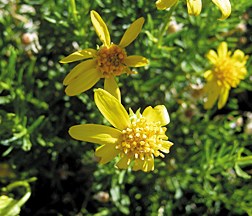
Linear-leaved GoldenbushEricameria linearifoliaMarch–May Several species of goldenbush occur in the park, but the narrow linear leaves and solitary flowering heads distinguish this one from the others. When in bloom this woody shrub puts on quite a display of large yellow flowers. This evergreen shrub is one of 36 species in the genus, all of which are confined to western North America; here in the park we have seven species. 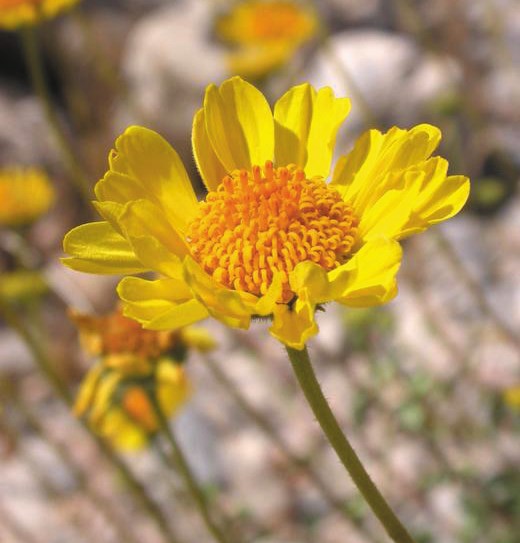
Acton's BrittlebrushEncelia actoniFebruary–July This drought-deciduous shrub is common above 2,600 feet (800 m) in the park, generally growing on exposed, rocky slopes. You can distinguish Acton’s brittlebush from its close relatives by its silvery green leaves and unbranching inflorescence. Each flowering stalk will only bear one flower; the ray flowers, resembling petals, are slightly toothed. 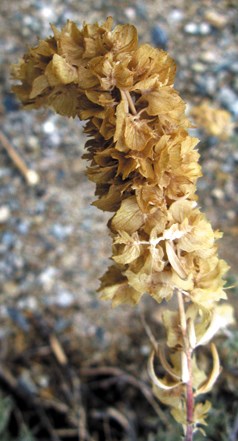
Fourwing SaltbushAtriplex canescensMarch–August Fourwing saltbush does not have large or showy flowers, but the fruits have four conspicuous bracts that turn into papery wings. The fruits are dispersed by the wind. You can find this species throughout the western US, occurring in a variety of habitats from sea level to 7,000 feet (2,100 m). The Cahuilla and Serrano people used the roots as soap and the small seeds as a food source. 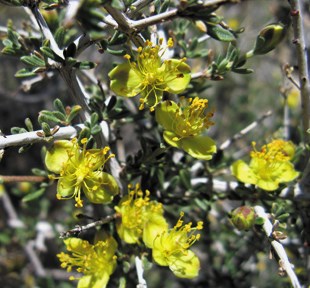
BlackbrushColeogyne ramosissimaApril–June This slow-growing shrub belongs to the rose family, which also includes strawberries and numerous fruit trees. The flower is atypical for the family, as it has four yellow sepals and no petals. Although the dark gray or almost black stems give this compact shrub a dark hue on the landscape, when in flower it is quite showy. You will often see blackbrush in dense stands, demarcating an altitudinal belt between creosote bush scrub and juniper-oak woodlands. It sets seed infrequently, and the seedlings survive with even greater rarity. However, like many desert shrubs, it is very long lived; blackbrush can live as long as 400 years. It is an important winter browse species for mule deer and bighorn sheep. 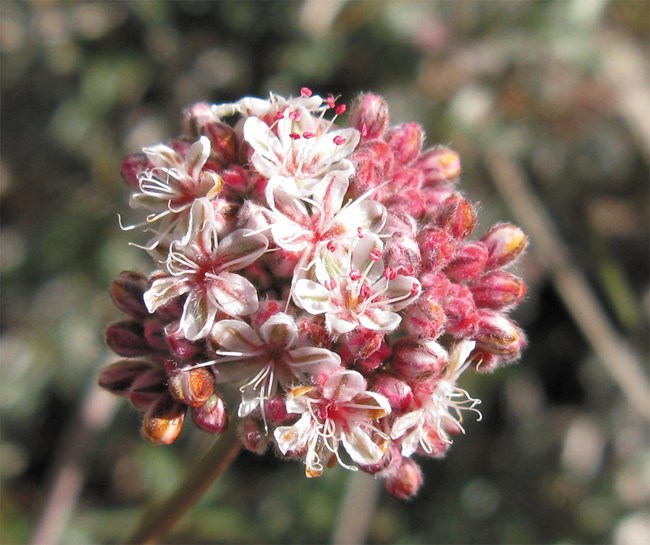
California BuckwheatEriogonum fasciculatumall year One of 25 distinct buckwheat taxa that occur in the park, you can easily identify this one by its dense white clusters of flowers found at the top of leafless stems. California buckwheat is a favorite of native bees and butterflies—and of humans as well. The Cahuilla gathered and ate the young shoots of the plant in the spring and seeds in the summer. They also utilized the plant as a medicinal substance, brewing strong teas of the leaves and flowers. 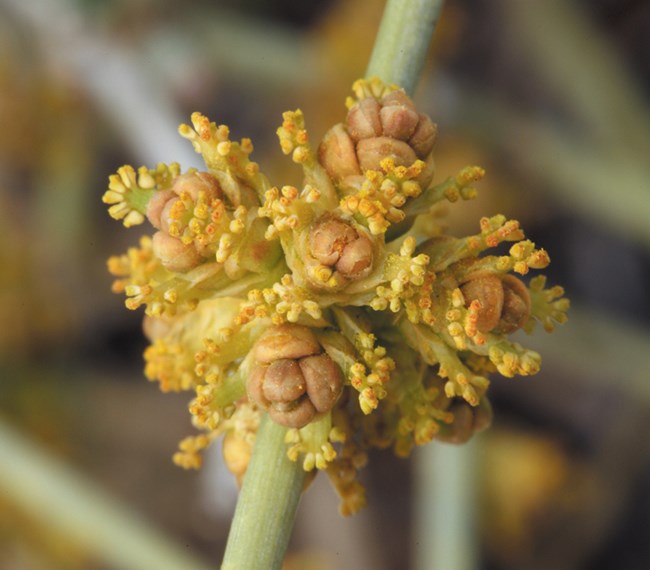
Steve Matson Nevada JointfirEphedra nevadensisMarch–June The ephedras, or jointfirs, are part of a larger group of plants often called “gymnosperms.” This group includes ginkgo, pines, and cycads, most of which produce seed-bearing cones. The small swellings, or galls, that you can find on many stems of jointfir are made by the fusiform gallfly (Lasioptera ephedrae). The stems of jointfirs contain a considerable amount of tannin that, when boiled into a decoction, makes a delicious tea used to treat intestinal ailments. 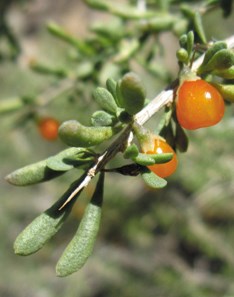
Anderson's BoxthornLycium andersoniiMarch–May This large spiny shrub is rounded and very branched; you will often find it growing in gravelly washes or rocky benches. The short linear leaves are glabrous and generally elliptic in cross-section, looking like tiny pickles. The red berries, if present, are an excellent food source for Gambel’s quail, as are the juicy leaves. The Cahuilla historically ate the berries fresh, or dried and ground them for future use. 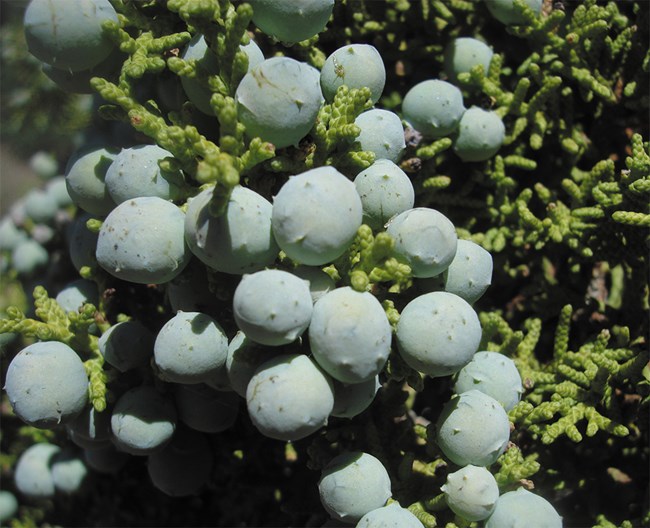
California JuniperJuniperus californicaDue to its multiple sprawling trunks, California juniper often looks more like a shrub than a tree. You will find it growing on dry rocky slopes between 2,500-5,300 feet (750-1,500 m). This species occurs mainly within California. The berries on this plant are actually small, fleshy cones that need two years to mature! The foliage consists of tiny scale-like leaves pressed tightly to the branch, and can vary from green to gray-blue. The juniper hairstreak (Callophrys gryneus loki) butterfly uses the California juniper as a larval foodplant. 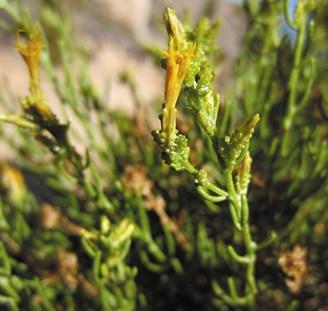
Terete-leaved RabbitbrushEricameria teretifoliaSeptember–November This plant was once considered a member of the genus Chrysothamnus, commonly called rubberbrush due to the high-quality rubber that can be extracted from the latex found in the leaves and bark. (The Paiute used to chew the bark of this species like chewing gum.) As a result of molecular tools, plant taxonomists have now placed this species into the genus Ericameria. Its highly resinous leaves are small and nearly cylindrical, distinguishing it from the linear-leaved goldenbush, but the resin-dotted phyllaries—bracts at the base of the flowering head—are a sure-fire way for you to identify this species. 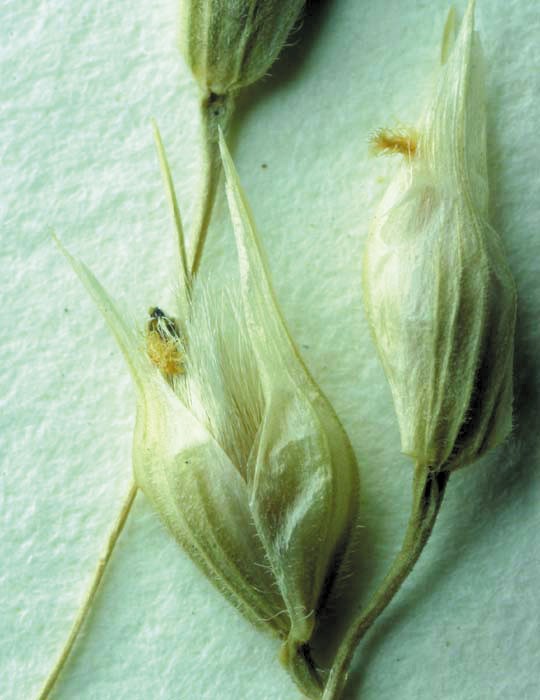
Steve Matson Indian RicegrassStipa hymenoidesApril–July As the name suggests, the Chemehuevi used Indian ricegrass as a food crop. They ate the seeds raw or ground them to flour and made cakes. The inflorescence of this grass is many-branched, lending it an airy appearance. The seed of Indian ricegrass is also a staple for many desert rodents, birds, and rabbits. 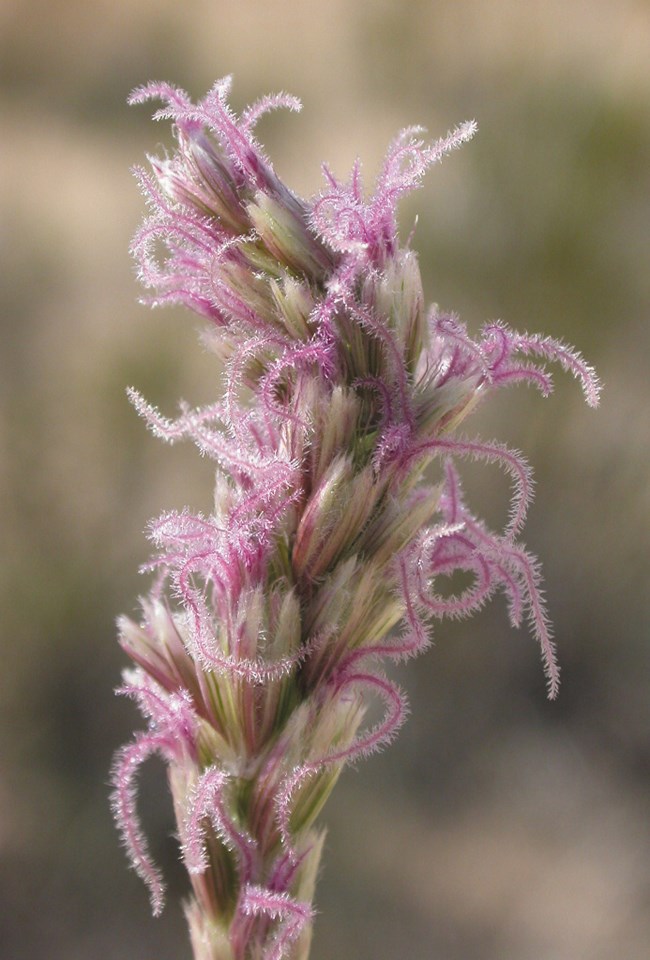
James Andre Big Galleta GrassHilaria rigidaall year This robust, bush-like grass grows from underground stems called rhizomes. This habit makes big galleta effective at stabilizing sandy habitats. Like all grasses, big galleta is wind-pollinated. Unlike most grasses, it has solid stems. The stems are covered in woolly hair, making the grass feel almost like felt. In springtime, you can recognize this common member of lower elevation Joshua tree woodlands by its pink tinted inflorescence. Even after the flowers and seeds have all fallen off, you can spot the zigzag shapes of the dry, wiry stems of the old inflorescences. 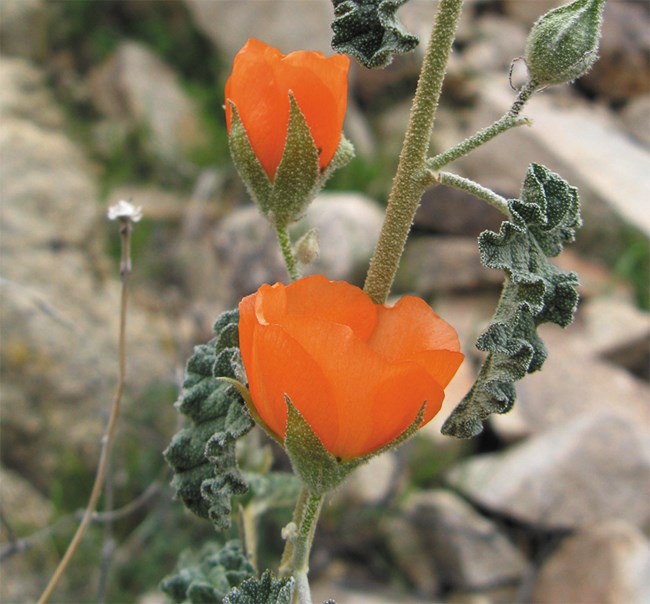
Apricot MallowSphaeralcea ambiguaFebruary–July With its bright orange flower, the apricot mallow is one of the most charismatic plants of the park flora. If you look inside the flower you will see its centrally fused stamens that are characteristic of members of the hibiscus family (Malvaceae). The crinkled, crenulated leaves and silvery stems of this plant are also distinctive, but be careful – they are covered in stellate hairs that can be irritating to the skin and eyes. 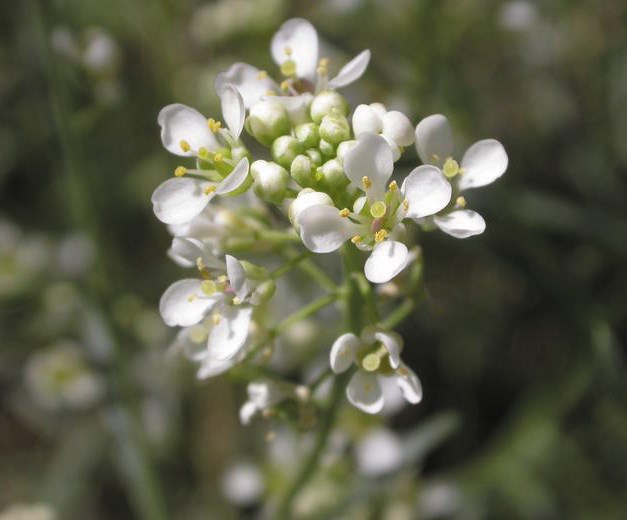
Desert AlyssumLepidium fremontiiMarch–June The desert alyssum is a relative of such plants as broccoli, kale, and brussel sprouts; they are all in the mustard family (Brassicaceae). Although the leaves smell like green vegetables, the flowers have an aroma of sweet honey. The leaves are thread-like and sometimes lobed; the seedpods are round, flat, and seamed down the middle. 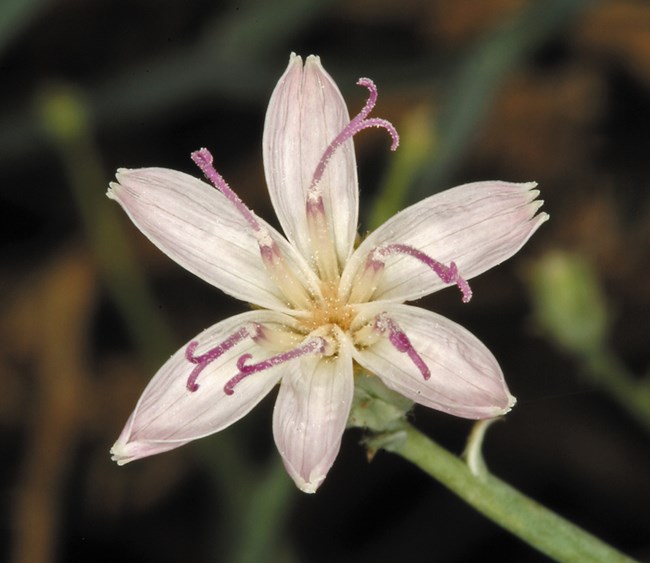
Steve Matson Brownplume WirelettuceStephanomeria paucifloraMarch–November This small shrub has an intricate branching pattern, with inconspicuous leaves. The pale pink to lavender flowering head is a composite of multiple flowers, as with all members of the Sunflower family (Asteraceae). In this case, you will see only strap-shaped florets called ligules, or ray flowers. The sunflower family is one of the largest plant families in the world with approximately 24,000 species. 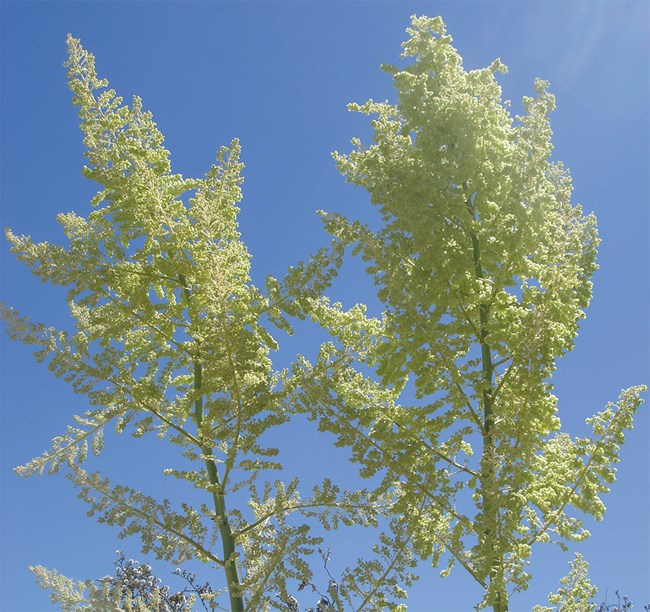
Parry's NolinaNolina parryiMay–June Nolinas are frequently mistaken for a species of Yucca or Agave, and while they are closely related they differ in two major ways. First, Nolina have long thin pliant leaves that will not hurt if you bump into them; secondly they are dioecious— meaning individual plants produce female or male flowers, but not both. The tall 4-12 foot tall (1-4 meters) majestic inflorescence of Parry’s nolina consists of small white unisexual flowers, which are visited by a number of pollinators, including Mesepiola specca, a member of the yucca moth family. The larvae of these moths feed on the seeds and then drop to the ground to pupate. 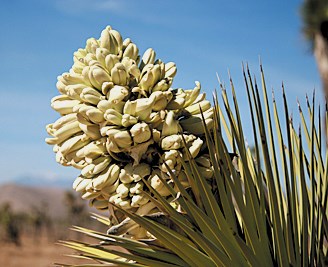
Joshua TreeYucca brevifoliaApril–May Seeing Joshua Tree National Park’s namesake indicates that you are definitely in the Mojave Desert, the only place in the world where it grows. You can’t age a Joshua tree by counting its growth rings because there aren’t any: these monocots do not produce true wood. Like all yuccas, Joshua trees are pollinated by yucca moths (Tegeticula spp.) that specialize in active pollination, a rare form of pollination mutualism. The female moth lays her eggs inside the flower’s ovary, then pollinates the flower. This ensures that when the larvae emerge, they will have a fresh food source—the developing seeds! 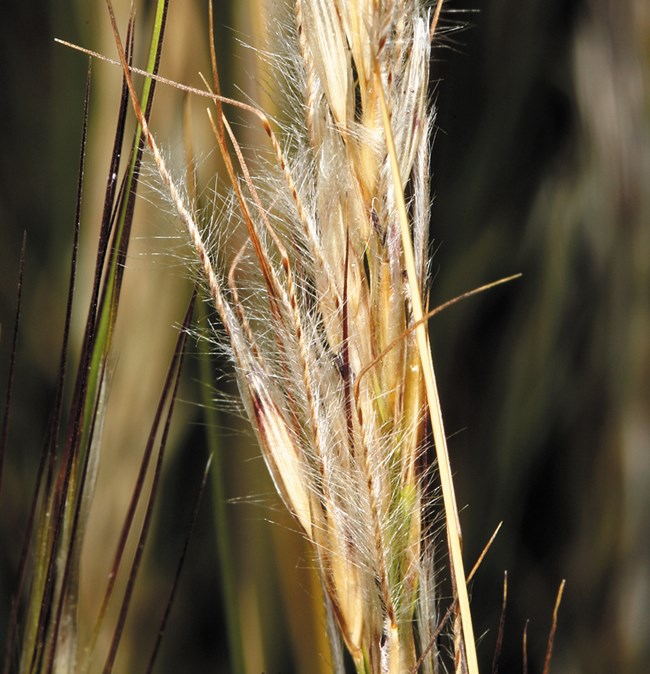
Steve Matson Desert NeedlegrassStipa speciosaApril–July Each flower of this species has a 1.5 inch (4 cm) long bristle, known as an awn; this needlelike structure has a bend in the middle and short white fuzzy hairs just below the bend. You can see the fuzzy awns from a distance, giving this perennial bunchgrass a feathery appearance. Many species of Stipa have grains that were gathered, cooked, and then eaten like rice by Native Americans. 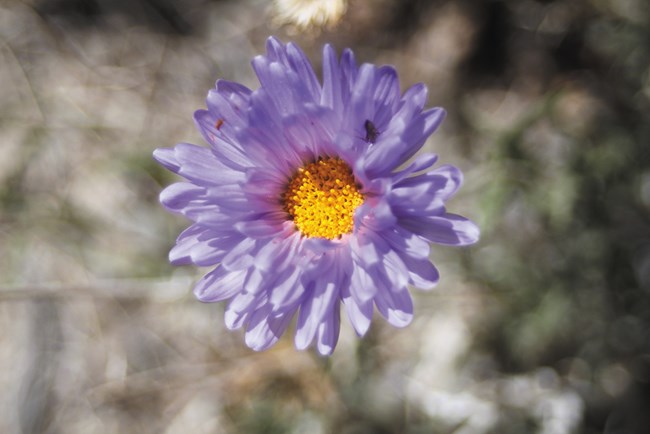
Mojave AsterXylorhiza tortifoliaMarch–Juney, October The Mojave aster is a showy species due to the large flowering heads with purple ray flowers and yellow disc flowers in the center. This small shrub is the larval host plant for the desert checkerspot, a common desert butterfly, as well as a fuzzy Noctuid moth, Schinia ligeae. If you watch, you may see one of these insects visit the plant. |
Last updated: July 2, 2019
